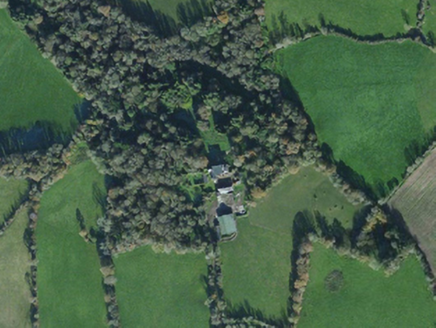Survey Data
Reg No
15702139
Rating
Regional
Categories of Special Interest
Architectural, Artistic, Historical, Social
Original Use
Country house
In Use As
Country house
Date
1700 - 1777
Coordinates
313451, 139968
Date Recorded
14/08/2007
Date Updated
--/--/--
Description
Detached five-bay three-storey country house, extant 1777, on a T-shaped plan centred on single-bay single-storey projecting porch to ground floor. Damaged, 1798. Occupied, 1901; 1911. Vacated, 1962. Sold, 1963. Replacement flat roof behind parapet, rendered chimney stacks having capping supporting terracotta or yellow terracotta pots, and concealed rainwater goods retaining cast-iron hoppers and downpipes. Rendered walls with concrete coping to parapet. Square-headed central window opening in bipartite arrangement (porch) with cut-granite sill, timber mullion, and moulded rendered surround framing four-over-four timber sash windows. Central door opening into country house. Square-headed window openings with cut-granite sills, and moulded rendered surrounds framing six-over-nine (ground floor), six-over-six (first floor) or three-over-six (top floor) timber sash windows. Set in landscaped grounds with part creeper- or ivy-covered rendered, ruled and lined piers to perimeter having ball finial-topped cut-granite capping.
Appraisal
A country house representing an important component of the domestic built heritage of County Wexford with the architectural value of the composition, one annotated as "The Island [of] Bolton Esquire" by Taylor and Skinner (1778 pl. 144), confirmed by such attributes as the deliberate alignment maximising on scenic vistas overlooking wooded grounds; the compact rectilinear plan form centred on 'a blocked architrave doorcase with sidelights' (Craig and Garner 1975, 61); the diminishing in scale of the openings on each floor producing a graduated visual impression; and the parapeted roof. Having been well maintained, the form and massing survive intact together with substantial quantities of the original fabric, both to the exterior and to the interior where contemporary joinery; restrained chimneypieces; and plasterwork refinements, all highlight the artistic potential of the composition. Furthermore, adjacent outbuildings (----); and 'gate piers [with] most unusual pineapple [finials] like tulips in shape' (ibid., 61), all continue to contribute positively to the group and setting values of an estate having historic connections with the Bolton family including William "Black Billy" Bolton (1720-76); William Bolton (----), one-time High Sheriff of County Wexford (fl. 1789); William Bolton (1782-1853); William Bolton JP DL (1815-1905), one-time High Sheriff of County Wexford (fl. 1856); and William Bolton (1850-1923).

